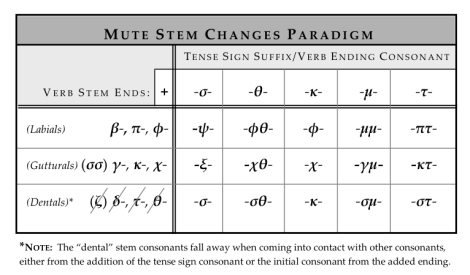I’ll not remain mute about this. I’ll teach you something about “Mute Stem” changes (JPEG) within Greek verbs, so you won’t need to remain “mute” about the subject, either! As a New Testament Greek student it can be helpful in the “short run” (or longer) if you can visualize in your “mind’s eye” certain critical pieces of information. Some of that critical information is this: “What happens when certain Greek consonants collide with other Greek consonants, and why?“ Please read the following treatise on “Mute Stem” changes where, below the following chart, I will give you a fairly easy way to “set up this chart” in your mind.
The basic components (the “labials,” “gutterals” and “dentals”) of the above “Mute Stems Changes”chart can be fairly easily replicated in your mind if you remember this “set up” process. While these three categories of Greek letters (“labials,” “gutterals” and “dentals”) are listed horizontally as they function within the chart, it’s easier to set them up vertically. Here’s how:
(1) Start reciting the Greek alphabet: α…β…γ...δ…then start writing the letters (vertically) as soon as you get to β, γ, δ. You now have the first letter of each of the three categories of letters.
(2) Next, vertically write (with Greek letters) the first letters of the acronym:“preachers’ kids (are) terrific”…or…π, κ, τ. Now you have the second letters of each row.
(3) For the final vertical row, add the Greek equivalent of an“h” to the letters you just wrote (π, κ, τ), resulting in: φ, χ, θ. With this done, you can now more easily memorize the results of collisions with various consonants that occur.
Go to: Wermuth’s GREEKBOOK.com
Wermuth’s GREEKBOOK Now Available for Purchase as a Watermarked PDF!

